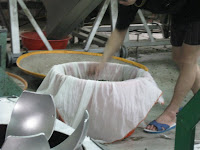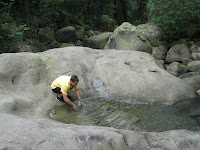
I, along with three other UPS students, left the World Scholar House hostel in Taipei and headed down the western Taiwan coast to Taichung city last Sunday.
Staying at the hostel was a good experience. I met people from all around the globe. Here are a few of the people I met there.
Getting to Taichung was relatively fast. From the hostel we piled in a taxi, with all our luggage barely fitting. The taxi ride was short to the high speed rail (HSR) station and inexpensive, especially since there were four of us to split the bill.

The day before we left we reserved tickets for the HSR, simply called Gao Tie (High Rail) in Taiwan. The tickets were $430NT about $13US. Many people take the HSR as opposed to taking a bus north or south. For one, it is quicker, but it is also less of a hassle if you have luggage. Everyone is given an assigned seat, so if you're with a group and want to sit together, purchase the tickets all together and split the cost.

Same thing if you go to a movie, seats are assigned. I saw transformers in the theater while in Taipei. It was actually a cool experience to sit among Taiwanese and listen to their reaction to the movie. They didn't get the whole moving into college freshman year part - probably because they didn't understand that American university dorm rooms don't have computer labs in them...
The HSR travels at speeds close to 186 MPH, however the ride is smooth and feels more like 40 MPH. We sat in the first car, at the front of the train. Inside, the cars are very clean and the seats are comfortable with lots of leg room.
Peering out from the window, the western lowlands whip by, filling the windows with agricultural crops instead of buildings. The change from dense city to rural town was dramatic. It seemed within seconds we were far removed from the hussle and bussle of the city and transplanted to a place where the clouds move faster than we do. Well, Taichung isn't quiet such a utopia. Scooters still line the streets, the horns still honk, and the people still have places to go.

Taichung, from my experience, is a city occupied by college students. It has a younger, warmer feel. The people are more friendly than Taipei it seems. Three universities are located in Taichung. I am attending Tunghai (pronounced with a D - as in Donghai) Da Xue (sounds like shway). DaXue means university, or literally, "big school."
The campus is very nice. The pathways around campus are lined with trees. Students chat all around campus. Even in summer, students can be seen walking from class to class. The swimming pool is nice, although not free, but definitel

y worth $40NT during the hot days. The gym is also $40NT to use. It has basic weight and aerobic machines and free weights - all one really needs.
I have four classes in the Chinese Language Center (CLC). From 8am to 12pm I attend class, then from 2pm to 4pm I attend study hours. For two classes Max, another UPS student, and I are the only students in the class. We are very lucky to have such a small class. For us, the pace of the class is perfect. Because there are only two of us, we really need to prepare and know the lesson before class. It forces us to be on top of our studies. Although I have taken three years of Chinese in the States, it is not the same. I feel like I have learned more in the week and three days of being here than I have in the months time in the States. Mainly because when you finish class for the day you return to speaking English. Here, after class you go to lunch and order in Chinese, you go to the store and ask questions in Chinese. It truly is the way to learn a language. If I were to figure how many hours I expect to spend a week on studying Chinese I would ball park the number around 100 hours a week. 20 hours of class, 10 hours of study sessions, 20-30 hours of homework, and 40-50 hours of speaking Chinese. Today I probably spoke English for 5 hours if I add it all up. One of my goals is to reduce the amount I speak English less and less each week. The bulk of speaking English is with my two American roommates and the other UPS students. As we continue our studies I assume we will rely less and less on English.
My dorm room here is actually bigger than what I had at UPS my freshman year. The dorms at UPS are considered to be very big compared to many other universities. Although, I only had one roommate then.

Now, I have three roommates. Max, Cole (a high school student from San Francisco taking classes for a month), and George (his American name - but nonetheless a Taiwanese student). George is a great resource.

He doesn't speak much English, which is great. He has already been a great help to getting Max and I situated.
My desk is a good spot to study - perfect lighting, enough desk space, enough drawers and bookshelves. However, I could go for a better bed... I am about an inch padding from the wooden board below.

Its a pretty stiff bed. Bedding does not come with the room. You have to buy it yourself. The school helped us purchase bedding, but I found where they sell the bedding for cheaper than what I paid - and they have bedding that is much thicker. I am sure I will probably upgrade to a thicker pad before my back has had enough.
Above the school there is a night market (Ye4 Shi4 - 夜市) - everything you need is there, somewhere... just have to look, sometimes really hard. The food is both delicious and cheap. I bought dinner the other night, paid $30NT for a full meal, which is under $1US. Things like food and clothing sell for much less than the States. Electronics are also a little cheaper, but for brand name electronics like Apple its the same. Although, you can find ripoff ipods and other electronics all over.
Upon coming to Tunghai DaXue, we were shown around campus by a group of students and a teacher assistant, Yenshin Liu. They were very warm, helping us speak Chinese and taking us to buy shaved ice and play billiards.

The next day Yenshin, we call him Liu Laoshi (teacher), and Huang Laoshi (another teacher assistant) took us to Xi-Tou up in the mountains. I have to say, Xi-Tou was one of the most beautiful places I have been.

First, we went to taste tea at a tea garden and learn about how the tea is picked, prepared, and packaged. We tried the local wu-long tea.

It was very fresh, and delicious.
After drinking tea, we were invited for a traditional dinner. The food was prepared in bamboo trays and we ate out of bamboo bowls.

All kinds of foods were prepared for us, too much to eat. I honestly can't remember all the different foods we ate, but some of it was rice (of course), yam and pig feet, pumpkin and pork, and I think radish and fish. The bamboo trays, filled with food, are placed in a flame oven that looks like this:

Next, we traveled up the mountain and went on a nature walk. It was a little eerie, many bugs, saw a couple snakes, GIGANTIC spiders - gave us all an itchy feeling, but it was incredibly beautiful. Remember watching those kung fu movies filmed in densely filled bamboo forests? This was like that.

Here I am off the beaten path - I didn't stay out there long, haha - these spiders were lurking nearby.

Just to give you an idea of the size, this spider is about the size of my fist. Although not poisonous, it was still very creepy. I am sure you'll agree.
After our nature walk we visited a tea factory. We watched the process as whole tea leaves were finely broken down to small pieces and then densely bundled - then the process repeated with the same leaves over and over again.

In this picture to the right, they are packing the leaves in this clothe, which will then be wrapped, packing the leaves tightly. After the leaves are packed, they are spun in a machine and then unwrapped and then re-spun loosely in another machine.

Then, the process is repeated, until finally the leaves are fine enough for their liking. Here is a video of the wrapping process.
After visiting the tea factory, we took some of the freshly ground tea and went to a local's house to drink and taste it. Two things about that was cool. First, the tea was excellent. We must have sat there for about 2 hours drinking tea. The second was the listening to the daughter play some sort of string instrument.

The sound was incredible, she was very good. She must practice every day for hours.
That evening we stayed in Xi Tou national forest in a very nice hotel room. We had dinner at the hotel restaurant. I tried fish eye, pork feet, pork bone marrow - as well as the other foods. Surprisingly, the fish eye was not bad.

After dinner we played card games in Chinese. A good way to learn a language is to play a game, words are repeated over and over and you think about their meaning continually.


The next morning we went on a hike in the national forest. This was a very beautiful place. The weather was perfect. Little humidity, shade, and rivers to cool the head. Here I am testing the water - it was fre

sh, cool, refreshing. I know what you're probably thinking - bacteria, parasites, germs - why am I drinking this water? Well, I can't really give a solid reason other than I was thirsty - and the water looked clear and clean.

After trying the fish eye and pork feet, this water couldn't be much worse. Walking on we came to a waterfall pooling area, another place to wash the hands and face.



After hiking for about two hours it was lunch time. Again, we were treated to an amazing meal. Some traditional plates were served along with some new plates. Once more they served us way too much food - I am not complaining though. The food was excellent.



After lunch we walked down the street to another tea garden. Looking out the scenery was absolutely gorgeous.

After gazing at the horizon for a while we headed back to campus and called it a day.
The next, it was Wednesday, day we briefly met our professors and had another campus tour. Classes didn't start until Thursday for us, so we had a free day to roam around. I decided to take the opportunity and buy toiletries and such. I was able to buy hangers, an electric shaver, electric beard trimmer, laundry detergent, a towel, a clothes basket, 10 pairs of athletic socks, an internet cable (hence I am typing this blog!), hand soap, and a drying rack for all under $30US - Incredible. The beard trimmer alone would have been $19.95US back in the States... Now, when I said you can fin

d nearly anything at the night market, I meant it. Looking for a giant hanger? It's there.
Well, I have reached the end of the picture limit for this post. Now that I have internet I will continue my writing on a more regular basis.
- Ryan
